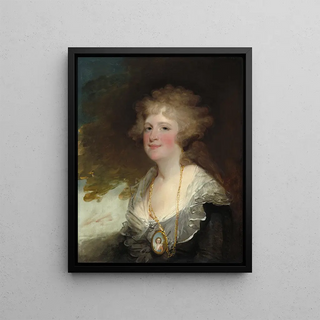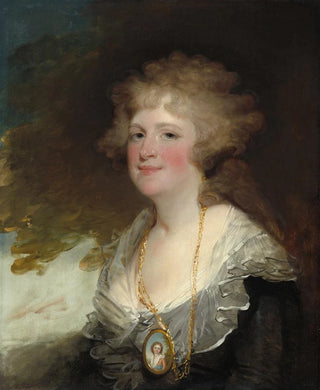Art print | Sarah Shippen Lea Mme Thomas Lea - Gilbert Stuart


View from behind

Frame (optional)
In the world of art, some artworks transcend their era to become symbols of a particular culture and sensibility. "Sarah Shippen Lea Mme Thomas Lea" by Gilbert Stuart is a perfect example. This canvas, which captures the grace and elegance of a woman from 18th-century American high society, immerses us in a time when portraiture was not only a means of representation but also a social statement. Through this work, Stuart invites us to explore the subtleties of female identity and the role of women in the emerging society of the United States, while revealing his undeniable talent for capturing human emotions.
Style and uniqueness of the work
Gilbert Stuart's style is distinguished by its striking realism and ability to convey deep emotions. In "Sarah Shippen Lea Mme Thomas Lea," he uses a palette of soft colors and shadow play that bring the face of his model to life. The light gently caresses Mme Lea's features, emphasizing her serene and thoughtful expression. The background, for its part, blends harmoniously with the subject, creating an intimate atmosphere that invites the viewer to come closer. The artist, by choosing to depict his model in a slightly tilted pose, manages to establish a silent dialogue between her and the observer, making the artwork even more captivating. Every detail, from the fabric of the dress to the delicate accessories, reflects meticulous attention that makes this portrait a masterful work of the genre.
The artist and his influence
Gilbert Stuart, born in 1755, is often regarded as one of the greatest American portraitists. His career, marked by exceptional talent and a deep understanding of human psychology, allowed him to paint some of the most influential figures of his time, including President George Washington. Stuart managed to blend European tradition with American sensibility, thus building a bridge between two artistic worlds. His influence endures today, both in the way he shaped American portraiture and in his approach to light and color. By paying tribute to female figures like Sarah Shippen Lea, he also contributed to redefining the role of women in art, offering them visibility that was

Matte finish

View from behind

Frame (optional)
In the world of art, some artworks transcend their era to become symbols of a particular culture and sensibility. "Sarah Shippen Lea Mme Thomas Lea" by Gilbert Stuart is a perfect example. This canvas, which captures the grace and elegance of a woman from 18th-century American high society, immerses us in a time when portraiture was not only a means of representation but also a social statement. Through this work, Stuart invites us to explore the subtleties of female identity and the role of women in the emerging society of the United States, while revealing his undeniable talent for capturing human emotions.
Style and uniqueness of the work
Gilbert Stuart's style is distinguished by its striking realism and ability to convey deep emotions. In "Sarah Shippen Lea Mme Thomas Lea," he uses a palette of soft colors and shadow play that bring the face of his model to life. The light gently caresses Mme Lea's features, emphasizing her serene and thoughtful expression. The background, for its part, blends harmoniously with the subject, creating an intimate atmosphere that invites the viewer to come closer. The artist, by choosing to depict his model in a slightly tilted pose, manages to establish a silent dialogue between her and the observer, making the artwork even more captivating. Every detail, from the fabric of the dress to the delicate accessories, reflects meticulous attention that makes this portrait a masterful work of the genre.
The artist and his influence
Gilbert Stuart, born in 1755, is often regarded as one of the greatest American portraitists. His career, marked by exceptional talent and a deep understanding of human psychology, allowed him to paint some of the most influential figures of his time, including President George Washington. Stuart managed to blend European tradition with American sensibility, thus building a bridge between two artistic worlds. His influence endures today, both in the way he shaped American portraiture and in his approach to light and color. By paying tribute to female figures like Sarah Shippen Lea, he also contributed to redefining the role of women in art, offering them visibility that was






